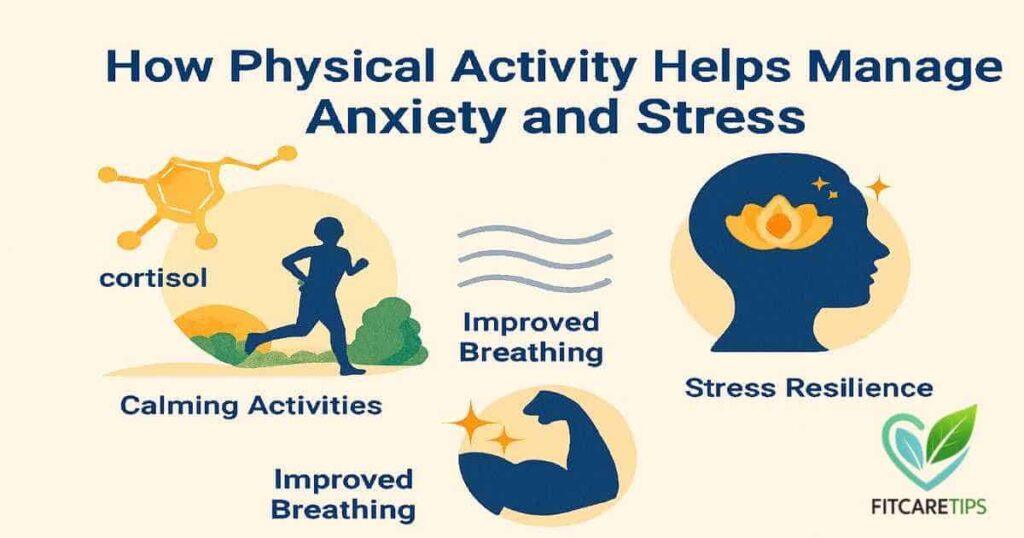Introduction — Why Physical Activity Matters for the Mind
Exercise and mental health are deeply connected in today’s fast-paced world, where emotional well-being matters more than ever. Many people today face challenges like depression, anxiety, and chronic stress that affect how they think, feel, and live. However, there is a powerful tool that can help — physical activity.
Moving your body does more than keep you fit; it boosts your mental health and overall happiness. This highlights the vital link between exercise and mental health for lasting well-being. By including exercise in your daily life, you can improve mood, sharpen focus, and build lasting emotional strength.
Mental health problems have become common, but physical activity offers hope. It can reduce feelings of sadness and tension. This article explores how exercise changes the brain and body. It highlights its role in fighting mental health disorders and improving life quality. Whether you’re new to exercise or want to understand its impact, this guide will offer clear, useful knowledge to empower you.
The Science Behind Exercise and Mental Health
When you exercise, your brain releases chemicals called endorphins, which create feelings of happiness and reduce pain. These beta-endorphins interact with the brain’s opioid system, helping to fight depression and anxiety. Additionally, physical activity helps balance the hypothalamic-pituitary-adrenal (HPA) axis, the body’s stress response system. When the HPA axis functions well, your body handles stress more efficiently, lowering harmful cortisol levels.

Exercise also increases brain-derived neurotrophic factor (BDNF), a protein that supports brain cell growth and repair. Higher BDNF improves cognitive function and protects against mental decline. Studies show that regular physical activity reduces inflammation in the brain, a factor linked to many psychiatric disorders. Exercise is an all-natural treatment to fight depression giving one example of how movement positively affects mental health.
These changes lead to better mood, improved memory, and overall mental clarity. That’s why the study of exercise and mental health is growing across neuroscience and public-health research.
| Key Brain Benefits of Physical Activity | Effects on Mental Health |
| Increased Beta-Endorphins | Reduced depression and anxiety |
| Balanced HPA Axis | Better stress management |
| Higher BDNF Levels | Enhanced cognitive function |
| Lowered Inflammation | Protection against mental illness |
Exercise and Mental Health: A Natural Treatment for Depression
Depression affects millions with persistent sadness, fatigue, and loss of interest. Many rely on medication, but physical activity is a proven natural remedy. It releases beta-endorphins and increases dopamine, the brain’s reward chemical. This improves mood and motivation. People who exercise regularly often experience milder depressive symptoms and higher energy levels.
Clinical studies show that moderate exercise like walking or swimming three times a week significantly eases depression. It works on both body and mind, improving self-esteem and reducing loneliness. Exercise also promotes better sleep, essential for emotional health. This makes physical activity a powerful part of managing depression alongside traditional treatments. In practice, combining exercise and mental health–focused routines often produces better outcomes than either approach alone.
How Physical Activity Helps Manage Anxiety and Stress
Anxiety triggers a fight-or-flight response, flooding the body with cortisol and adrenaline. Too much of this can harm the brain and body. Physical activity calms this reaction by lowering cortisol and activating the autonomic nervous system, which helps the body relax. Movement also improves breathing patterns and focuses the mind, reducing worry and nervousness. Regularly integrating exercise and mental health practices — for example breath-focused aerobic work — helps reduce persistent anxious thoughts.

People who engage in aerobic exercise such as running, cycling, or dancing often feel calmer and more balanced. Exercise increases mindfulness, helping you stay present instead of getting lost in anxious thoughts. Over time, these effects build stress resilience and improve overall mental health, making anxiety easier to manage.
Exercise and Mental Health in Trauma and PTSD Recovery?
Trauma and post-traumatic stress disorder (PTSD) deeply affect the nervous system. Many with PTSD suffer from hypervigilance, nightmares, and emotional numbness. Physical activity helps regulate the HPA axis and calms the overactive nervous system. Through movement, trauma survivors reconnect with their bodies and control physical sensations linked to fear. Evidence shows tailored exercise and mental health programs can assist in down-regulating the stress response for many survivors.
Exercise also triggers the release of natural mood stabilizers like endocannabinoids, which reduce pain and promote relaxation. When combined with therapy, physical activity enhances recovery by strengthening coping skills and reducing PTSD symptoms. Programs involving yoga, walking, or tai chi show promise in improving trauma survivors’ quality of life.
The Role of Exercise in Treating ADHD and Focus
Attention Deficit Hyperactivity Disorder (ADHD) affects many children and adults. It causes difficulty focusing, impulsiveness, and hyperactivity. Research shows that physical activity increases brain chemicals like dopamine and norepinephrine, improving attention, impulse control, and executive function.

Aerobic activities such as running or swimming effectively manage ADHD symptoms. Short bursts of movement boost brain function and calm restlessness. Experts recommend daily exercise as a natural, safe complement to traditional ADHD treatments.Simple exercise and mental health strategies — short bursts of activity plus structure — help sustain attention and reduce impulsivity. This helps improve behavior and academic performance for children and adults alike.
Other Exercise and Mental Health Benefits of Routine Activity
Besides mood and focus, physical activity improves sleep quality, vital for mental health. Good sleep restores brain function and emotional regulation. Exercise also boosts self-esteem and promotes positive body image, enhancing overall self-worth.
Social interaction is another benefit. Group activities or sports build community bonds, reducing loneliness. Regular movement also lowers inflammation, linked to depression and cognitive decline. Together, these benefits offer a holistic boost to mental health, supporting long-term wellness.
How Much Exercise Is Enough for Mental Health?
Health experts recommend at least 150 minutes of moderate-to-vigorous physical activity weekly for mental health benefits. This can be divided into 30-minute sessions, five times a week. Even short 10-minute bouts of exercise improve mood and focus. Following clear exercise and mental health guidelines makes it easier to turn those short bouts into lasting habits.
Some follow a “weekend warrior” routine, exercising on fewer days. Research shows this still offers mental health gains, but consistency is key. Daily movement, regardless of duration, builds resilience and emotional balance over time. Tracking progress and setting achievable goals helps maintain this healthy habit.
Breaking Barriers: Common Challenges and How to Overcome Them
Starting or maintaining exercise routines can be difficult. Common obstacles include lack of time, motivation, and access to facilities. Mental health issues often cause fatigue and low energy, making it harder. Fear of injury or embarrassment may also hold people back.
Overcoming these barriers involves planning small, manageable activities. Walking during breaks, home workout videos, or community programs make exercise accessible. Social support and encouragement are powerful motivators. Remember, every step counts toward a healthier mind and body.
Easy, Everyday Ways to Stay Active Without a Gym
You don’t need a gym membership or equipment to gain mental health benefits from physical activity.The World Health Organization highlights that even light-intensity activities like walking or gardening contribute to overall mental well-being.
Walking your dog, gardening, or dancing at home counts as valuable movement. Taking stairs, biking to work, or playing active games with family add up.

Using smartphone apps or fitness trackers encourages consistency. Outdoor activities in parks or trails offer fresh air and a mental boost. The key is to find enjoyable ways to move that fit your lifestyle and schedule.
Making Movement a Fun and Sustainable Habit
Exercise sticks when it’s fun and rewarding. Choosing activities you enjoy makes it easier to keep going. Swimming, hiking, or team sports add variety and challenge, preventing boredom.
Setting realistic goals and celebrating milestones builds confidence. Group classes or workout buddies add accountability and social interaction. Listen to your body to avoid burnout and adjust routines. Sustainable habits create lasting mental health benefits.
When to Use Exercise and Mental Health Alongside Professional Mental Health Services
Though physical activity is powerful, it is not a replacement for professional help. Persistent symptoms of depression, anxiety, or other disorders require consulting a therapist or psychiatrist. Exercise works best as part of a holistic treatment plan.

Mental health professionals often recommend combining exercise, medication, and therapy for optimal outcomes. This approach addresses both body and mind. Many USA programs now include physical activity as a core part of mental health care.
Conclusion — A Stronger Body, A Calmer Mind
Regular physical activity reshapes body and mind. It reduces depression, soothes anxiety, sharpens focus, and builds emotional strength. Exercise is a natural, effective way to boost mental wellness and quality of life.
Start small, stay consistent, and make movement a joyful part of your day. Prioritizing exercise and mental health together ensures those small steps add up to meaningful change. Your mind and body will thank you with greater resilience, calm, and happiness. Remember, a stronger mind truly comes from a stronger life. For more tips and expert advice on strengthening mental and physical health through exercise, visit FitCareTips.
FAQS
Q1: How does physical activity improve mental health?
Physical activity releases endorphins and balances the HPA axis, which reduces stress hormones like cortisol. This improves mood, lowers anxiety, and enhances cognitive function, leading to better overall mental well-being. In short, exercise and mental health are closely connected and support mood regulation.
Q2: Can exercise help with depression and anxiety?
Yes! Exercise acts as a natural antidepressant by increasing beta-endorphins and dopamine, boosting self-esteem and energy. It also calms the nervous system, which helps reduce anxiety symptoms and improves sleep quality.
Q3: What types of exercise are best for mental health?
Aerobic exercises such as walking, running, swimming, and cycling are highly effective. Mind-body activities like yoga and tai chi also promote emotional resilience by combining movement with mindfulness and relaxation.
Q4: How much exercise do I need to improve my mental health?
The recommended amount is 150 minutes of moderate to vigorous activity per week, which can be broken into shorter sessions. Even 10-minute bouts throughout the day can provide mental health benefits.
Q5: Can exercise help with PTSD and trauma recovery?
Yes, physical activity helps regulate the HPA axis and reduce nervous system hyperactivity, easing PTSD symptoms. It works well alongside therapy to improve coping skills and emotional regulation.

“Abdul Rehman Shahzad – WordPress expert, SEO article writer, and website content creator at FitCareTips.”
